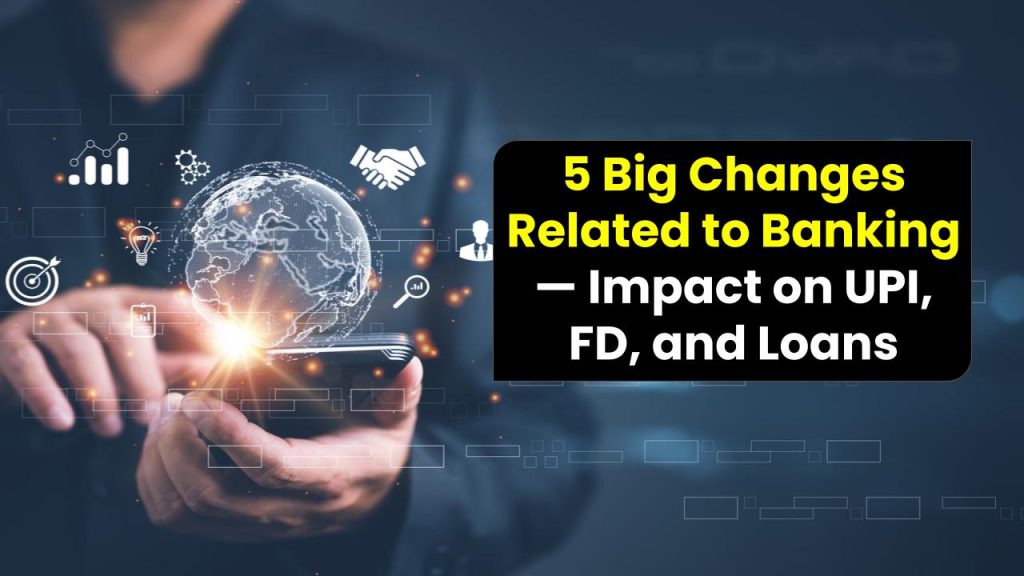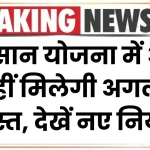
In a significant move to reshape India’s banking landscape, the Reserve Bank of India (RBI) has rolled out five major changes that directly impact how we use UPI, invest in Fixed Deposits (FDs), and borrow through loans. Whether you’re a working professional, a small business owner, or someone managing household finances, these updates are bound to affect your day-to-day financial life.
In this article, we break down these changes in a clear, simple way — easy enough for a 10-year-old to follow, but detailed enough for financial pros. We’ll explore what these policy changes mean, how they’ll impact your savings, borrowing, and payments, and what steps you can take to stay ahead.
5 Big Changes Related to Banking
| Change | What’s New | Who It Affects | Key Impact |
|---|---|---|---|
| UPI 123Pay Limit Increased | Raised from ₹5,000 to ₹10,000 | Feature phone users | Bigger payments via voice-based UPI |
| Priority Sector Lending (PSL) Revised | Broader loan categories and higher limits | Banks, rural borrowers | More loans for housing, renewables |
| New FD Rules for NBFCs | Tighter deposit norms, liquidity requirements | NBFCs, investors | Safer deposits, better protection |
| Loan Risk Weights Adjusted | Microfinance risk weight cut to 100% | Banks, small borrowers | Easier access to micro loans |
| Repo Rate Impact | Dynamic influence on loan EMIs and FD rates | All borrowers and savers | Lower EMIs, shifting interest income |
The RBI’s latest changes reflect a careful balance between financial inclusion, risk management, and economic growth. Whether you’re managing your household, running a business, or working in banking, understanding these updates can help you make smarter, safer financial decisions.
With UPI becoming more inclusive, FDs more secure, loans more accessible, and policy clearer — now is the time to align your finances with India’s evolving banking environment.
UPI 123Pay Transaction Limit Doubled — Big Win for Feature Phone Users
If you’re using a basic phone and relying on voice-based UPI services, here’s some great news.
The National Payments Corporation of India (NPCI) has increased the limit for UPI 123Pay transactions from ₹5,000 to ₹10,000 per transaction. This system allows non-smartphone users to make digital payments using IVR (Interactive Voice Response) technology — a huge step toward financial inclusion.
Why It Matters:
- Over 40 crore people in India still use feature phones.
- With this limit increase, small traders and rural users can now pay for larger purchases or utility bills using voice commands.
- This supports RBI’s Digital India goals and boosts cashless payments in underserved areas.
Tip: If you have relatives in rural areas, help them register for UPI 123Pay by dialing 080-4516-3666 and linking their bank account.
see also: You Will Get Such Huge Returns on Depositing ₹1000, ₹2000, ₹5000 and ₹10,000!
Priority Sector Lending (PSL) Guidelines Overhauled
To strengthen credit flow in key economic sectors, the RBI has revised its Priority Sector Lending guidelines, effective April 1, 2025.
Key Changes:
- Loan limits for affordable housing have been increased.
- Renewable energy loans now include off-grid solutions like solar pumps and biogas.
- Urban Cooperative Banks now have a PSL target of 60% of their adjusted net bank credit.
These revisions aim to ensure better credit access to agriculture, MSMEs, housing, education, and green energy — all vital for inclusive growth.
Professional Insight: Banks that fall short of PSL targets must invest in low-yield funds like RIDF. Meeting targets helps them stay profitable while supporting key sectors.
New Fixed Deposit (FD) Rules for NBFCs and HFCs
If you invest in FDs through Non-Banking Financial Companies (NBFCs) or Housing Finance Companies (HFCs), here’s an important update.
From January 1, 2025, the RBI’s revised regulations require:
- Higher liquid asset maintenance (15% of public deposits).
- Stricter rules on deposit renewals and interest payouts.
- Better transparency in early withdrawal terms.
Why This Matters:
- Many savers choose NBFC FDs for higher interest rates compared to banks.
- These new rules enhance investor safety, especially during financial stress.
Tip: Always check the CRISIL or ICRA rating of the NBFC before investing. Prefer institutions with “FAAA” or equivalent high safety ratings.
Loan Risk Weights Adjusted — Easier Access to Micro Loans
In February 2025, the RBI announced a reduction in risk weights for consumer microfinance loans, bringing it down to 100% from 125%. This move is designed to:
- Help banks lend more to low-income individuals and self-help groups.
- Promote financial inclusion for first-time borrowers.
At the same time, the RBI has restored risk-based pricing for bank loans to NBFCs, based on their external credit ratings — meaning better-rated NBFCs get easier access to funds.
What’s the Benefit?
For borrowers: Easier loan approvals and possibly lower interest rates on small-ticket loans.
For banks: Reduced capital requirements and increased flexibility in lending strategies.
Repo Rate: The Silent Game-Changer for Loans and Deposits
The RBI repo rate — the rate at which it lends money to commercial banks — has a domino effect on both loans and deposits.
Although the current repo rate remains steady, any future adjustments will directly impact:
- Loan EMIs: A cut means lower EMIs on home, car, or personal loans.
- FD returns: A drop in the repo rate may lead to lower FD interest rates.
According to IndusInd Bank, a 0.25% repo rate cut could reduce a 20-year ₹50 lakh home loan EMI by approximately ₹750 per month.
What Should You Do Now? Practical Tips to Navigate the Changes
Here’s how you can take advantage of the new banking rules:
For UPI Users:
- Help older or rural family members use UPI 123Pay.
- Use secure voice prompts; avoid sharing your PIN.
For FD Investors:
- Stick with AAA-rated NBFCs for safer FDs.
- Compare FD rates across banks and NBFCs using RBI’s list of registered NBFCs.
For Borrowers:
- Monitor repo rate trends. If rates fall, consider refinancing your loan.
- Check if your microfinance lender has updated interest rates.
For Professionals:
- Track PSL norms if you’re in banking or finance.
- Adjust lending strategies to include renewables or housing, which now qualify under revised PSL.
see also: SBI Amrit Vrishti Scheme: Earn Rs 6,458 Monthly with a Lump Sum Investment
Big Changes Related to Banking FAQs
Q1. What is the UPI 123Pay limit as of 2025?
As of 2025, the UPI 123Pay transaction limit is ₹10,000 per transaction.
Q2. Are NBFC Fixed Deposits still safe after the new rules?
Yes, NBFC FDs are safer now due to stricter RBI regulations on liquidity and transparency.
Q3. Will my loan EMI change immediately with the repo rate?
Most floating-rate loans adjust within 3 months of a repo rate change. Fixed-rate loans won’t be impacted.
Q4. How does the PSL update affect common citizens?
More loans will be available for affordable housing, green energy, and MSMEs — promoting broader access to finance.
Q5. Where can I find official RBI circulars?
You can access official notifications at the RBI website.











